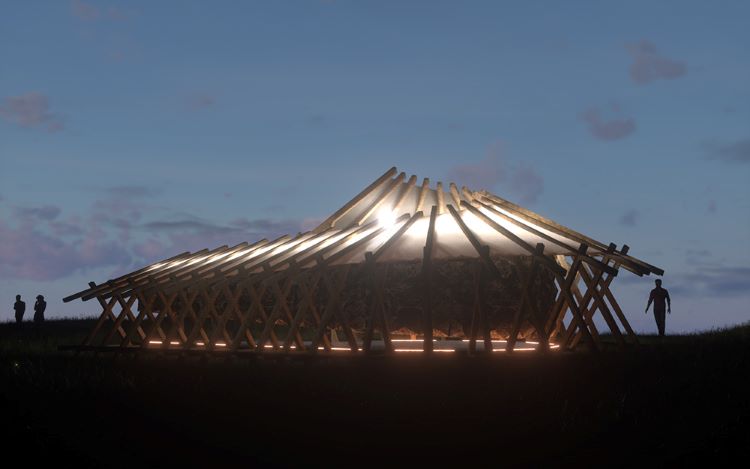Pavilion made of mushrooms to debut at Glastonbury Festival
Conceived by Temple Design director Simon Carroll, the 26-metre-long structure will aim to encourage the use of mycelium across multiple sectors.
Temple Design director Simon Carroll has designed Glastonbury’s first Hayes Pavilion for artistic research and development using mycelium in a bid to encourage its use in the creative sector and beyond.
The project has been led by Silver Hayes’ Team Love and Carroll, in association with Big Team CIC, Team Love’s inner-city youth outreach and engagement company, Glastonbury Festival, manufacturers, Biohm and biotechnology company Grown Bio. Carroll acquired funding for the project via the National Lottery and Arts Council England.

Carroll says he was first introduced to mycelium – the root organism of a mushroom – five years ago when he saw a talk about replacing packaging materials like polystyrene by Ecovative founder and CEO Eban Bayer CEO. Temple Design frequently uses polystyrene in sculpting for set design, which triggered Carroll’s research into how he could apply it in his work.
To make the mycelium material, the roots are placed into a mould where it grows and reconnects into a solid panel over a period of a week or two. Once it is ready, Carroll says he will approach it much how he would when assembling a polystyrene model, gluing it together.

The pavilion sculpture, designed to “mimic Fibonacci arcs”, will be 95% mycelium, with timber supports, bioplastics made from agar, and compostable gelatine glue. It will be 26 metres long, ten metres in diameter with an additional six-and-a-half-metre extension and stand at three and a half metres tall. Carroll estimates that it will take two weeks to build and complete.
Though mycelium has been researched and experimented with for around ten years, Carroll says his goal is to make it “more widely used”. He hopes that using it for the pavilion will encourage its wider use across multiple sectors, having a knock-on effect on the cost and manufacturing time.

Working with Biohm – which is looking to use mycelium as building material insulation – Carroll says he is experimenting with using mycelium as a “binder” for fibrous materials found in the “agricultural waste stream” such as hemp shiv, from the woody core of the hemp plant. If they can “inoculate” these biomaterials with a strain of mycelium, it could make stronger material more fit for building purposes, he suggests.
When Glastonbury ends, Carroll plans to take the pavilion on a tour, getting “as much time out of it as possible” and showcase what it can do. He says he is “in talks with a number of venues” and will be at Team Love events in September.

Team Love and Big Team are also leading a sustainability report, which will investigate the project’s “behavioural impact”, says Carroll, documenting when the team couldn’t use a sustainable option and why, as well as how materials from the pavilion can re-enter the supply chain. There will also be full carbon data collection to determine the carbon cost and environmental impact of the project overall.
Carroll explains that sustainability reports can often “costs thousands”, so are mostly inaccessible to smaller organisations and studios but he feels it important to “understand the data and the impact of our choices”.

Inside the pavilion, there will be an exhibition of 2D and 3D forms that intend to test the material’s creative limits. Carroll invited industry friends from institutes such as Central Saint Martins and the Royal College of Art to contribute, seeking to “increase the diversity of knowledge going into the project”, he says.
The overall aim is to educate students, the industry and the wider public about the opportunities that biomaterials like mycelium offer. Carroll thinks there is “a lot of commercial opportunity across markets to use mycelium”, adding that “anything you’ve seen with a polystyrene core can be challenged by this material”.
-
Post a comment





